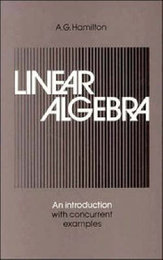
|
Linear Algebra: Volume 2: An Introduction with Concurrent Examples
Paperback / softback
Main Details
| Title |
Linear Algebra: Volume 2: An Introduction with Concurrent Examples
|
| Authors and Contributors |
By (author) A. G. Hamilton
|
| Physical Properties |
| Format:Paperback / softback | | Pages:340 | | Dimensions(mm): Height 229,Width 152 |
|
| Category/Genre | Algebra |
|---|
| ISBN/Barcode |
9780521310420
|
| Classifications | Dewey:512.5 |
|---|
| Audience | | Tertiary Education (US: College) | | Professional & Vocational | |
|---|
|
Publishing Details |
| Publisher |
Cambridge University Press
|
| Imprint |
Cambridge University Press
|
| Publication Date |
15 February 1990 |
| Publication Country |
United Kingdom
|
Description
This is a readable introduction to linear algebra, starting at an elementary level. The book is intended for use in courses for both students of pure mathematics who may subsequently pursue more advanced study in the area, and for students who require linear algebra and its applications in other subjects. Throughout the text, emphasis is placed on applications of the subject in preference to more theoretical aspects. Worked examples are provided on every left hand page to accompany the text on the right hand page, allowing the reader to follow the text uninterrupted. To be most effective, the book should be worked through and learned from, using numerous exercises with solutions. For first year undergraduates who need a basic grounding in linear algebra and students of mathematics, physics and engineering, this is an excellent introductory text. This is an expanded version of the author's previous book, A First Course in Linear Algebra.
Reviews'The book is clearly directed at students who have had little or no experience of solving linear equations at school. Moreover, it is intended for people who do not find learning mathematics easy. There are no short cuts, or bribes in the form of interesting applications, but the student who is motivated to learn about systems of linear equations, and willing to work through the exercises, will have an excellent opportunity to acquire proficiency and understanding.' The Times Higher Education Supplement
|